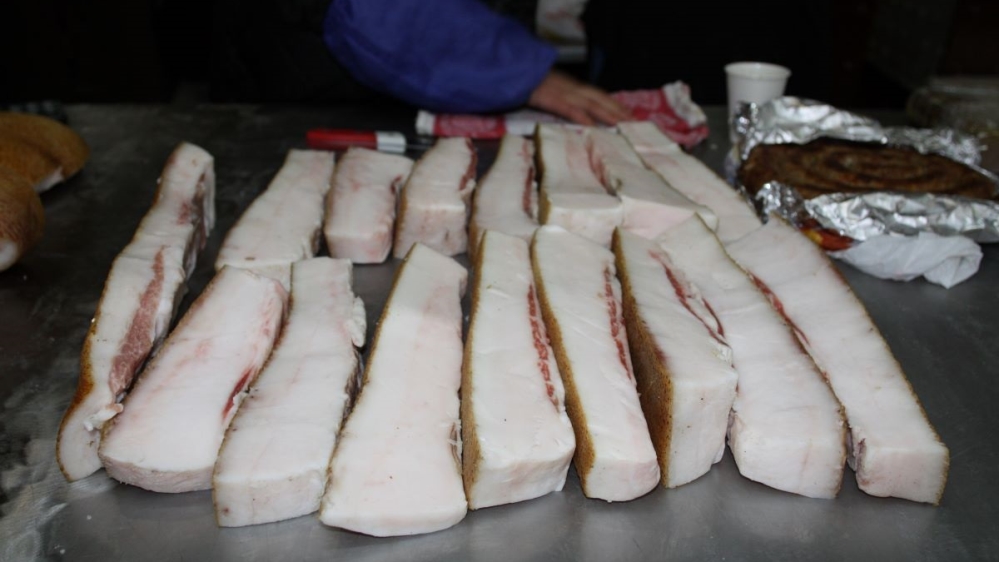Salo: Ukraine’s greasy national symbol
How one of Ukraine’s most beloved foods inspires comedic parodies and unexpected dishes.

Lviv, Ukraine – A Russian customs officer asks a Ukrainian man if he is carrying any drugs.
“Of course,” the man says. “Got three kilos here!”
Keep reading
list of 4 itemsThe surfer chef behind South Africa’s first fine dining halal restaurant
Why are Pakistan’s wheat farmers protesting against the government?
About 282 million people faced acute hunger last year: UN-led report
The Russian sees a chunk of salted, uncured pork fat. “But this is salo!” he says.
“Yes, and I am so addicted to it,” the Ukrainian responds.
This is one of many jokes about salo, one of Ukraine’s favourite foodstuffs that emblemises the ex-Soviet nation, its people and their culinary preferences. It has become a national symbol and object of gastronomic veneration, countless recipes and proverbs.
“If I were a lord, I would eat salo with salo,” one of these proverbs goes.
Ukrainians often treat their “addiction” with irony.
“Ukraine is not dead yet – while there is salo,” sang Ukraine’s future President Volodymyr Zelenskyy – clad in tight leather and sporting high heels – in a satirical music video shot in 2014 when he led District 95, a comedy troupe whose immense popularity propelled him to the presidency five years later.
Another humorous trend is to portray salo as something fashionable and cool. A viral meme described salo as “Dol’ki Kabana” (slices of hog) in a reference to the Dolce & Gabbana fashion company.
A salo museum
“Salo is Ukraine’s soul,” Oleksandr Kokozsky, a waiter at the humorous Salo Museum in the western city of Lviv, told Al Jazeera.
In this “museum restaurant” nestled in a spacious basement next to cathedrals and an opera house, patrons can try one of a dozen traditional dishes with salo such as borscht, a red soup with beetroots and sour cream, or vareniki, dumplings that can be stuffed with almost anything from cherries to cheese to, yes, salo.

One can also order a lard figurine of Elvis Presley or “Marilyn Monroe’s lips” made of raw pig fat and served with ice cream and fruit. If that does not sound exotic enough, one can try salo jam or chocolates with a tiny, marble-white piece of lard inside.
After an introduction to salo science and a couple of shots of gorilka, Ukrainian vodka, “foreigners are mesmerised”, said waitress Ulyana Gulyaka.
The museum also features somewhat slapstick “salo art,” including a greasy replica of the Black Square, Kazimir Malevich’s avant garde painting, and a canvas depicting Prophet Abraham killing a hog instead of the Biblical ram.
A practical fat
There are many explanations as to why Ukrainians are so addicted to salo.
One is practical – salo is extremely nutritious and needs no refrigeration. Huge slabs of fat are taken from a pig right after slaughtering and the salo is consumed raw, smoked, peppered, brine-fermented or fried. It is never cured and is mostly eaten cold.
Stashes of salo helped Ukrainian peasants stave off famines and survive foreign invasions. When the invaders were Muslim – either from the nearby Crimean Khanate or from its imperial master, Ottoman Turkey – they never pillaged pork and pigs.
![Sushi made of raw pork fat at the Salo Museum in Lviv [Mansur Mirovalev/Al Jazeera]](/wp-content/uploads/2020/01/b119c16925ff4ec6a561cb5e0145c6e0_18.jpeg)
Cossack warrior horsemen, another national symbol and whose election-based hierarchy is seen as a precursor of modern-day Ukrainian democracy, lived on salo during their months-long military campaigns.
So did chumaks, heavily-armed travelling salesmen whose caravans of buffalo-driven wooden carts trudged through mud or snow, delivering salt, dried fish and other essentials.
Deadly diet
Despite the conclusions of modern diet experts that pork fat is a source of cholesterol that clogs up one’s arteries – Ukrainians keep consuming salo.
“I just can’t help it, even if I don’t eat salo every day, I like having it in the fridge,” Oleh Prikhodko, a retired school principal who suffers from diabetes, told Al Jazeera after buying a chunk of peppered salo with garlic at the Bessarabsky market in central Kyiv, the capital.
Olena Demidko considers herself a vegetarian. The 29-year-old graphic designer prefers grilled vegetables, miso soup and brown rice. But every morning, she eats a slice of salo.
“Because my grandma told me it has all the vitamins one needs,” she said.
Contemporary medical science disagrees with her grandma.

In a 2018 study of links between dietary risk factors and cardiovascular diseases commissioned by the World Health Organization and conducted in 51 nations, researchers found that Ukraine is an unfortunate champion. Some 38 percent of deaths in Ukraine – the highest rate in Eastern Europe – were caused by diet-related cardiovascular diseases.
Ukrainian experts blame the mortality on a diet rich in animal fats, including salo.
“Salo is pure fat, it requires maximum efforts on the part of pancreas,” director of Ukraine’s Association of Dietologists, Oleh Shvets, said in televised remarks in 2019, adding that the safe amount of salo that can be consumed daily should not exceed 20g.
Economy and propaganda
Meanwhile, Ukraine’s obsession with salo has not translated into a boom in pig farming. Ukraine’s economy is still reeling from a disruption of economic ties with Russia and the devaluation of its currency, the hryvnia.
“Surprisingly … the cult of salo in Ukraine has not triggered the development of elite pig farms that develop special tastes of salo such as marble beef in Japan,” Aleksey Kushch, an analyst based in Kyiv, said.

Salo has also become an ideological weapon in what Ukraine calls a “hybrid” war with Moscow.
A “gastronomic-nationalist” festival dubbed SS – salo and samogon (moonshine) – was held in 2017 in the western city of Ternopil.
The abbreviation was a sarcastic reference to the SS, Nazi Germany’s dreaded Schutzstaffel paramilitary forces, because the organisers wanted to ridicule Russia’s efforts to present Ukraine as a nation taken over by “fascists” and “Nazis”.
In a promotional video, four armed men put together pieces of salo to form a map of Ukraine that includes Russia-annexed Crimea.
One of the men adds a chunk representing the southwestern Russian region of Kuban, where ethnic Ukrainians form a sizable community – and consume copious amounts of salo.
“Ukraine is where salo is!” the man proclaims.